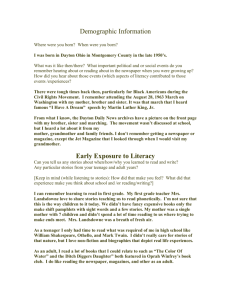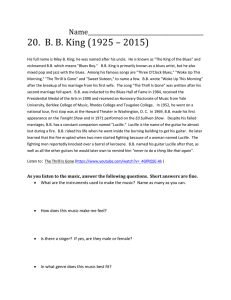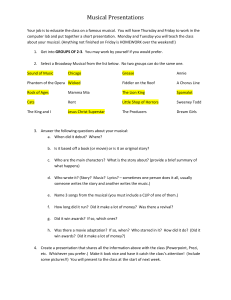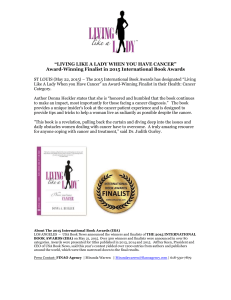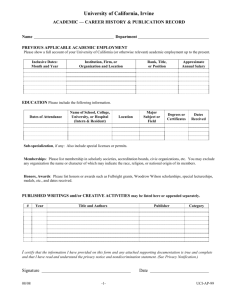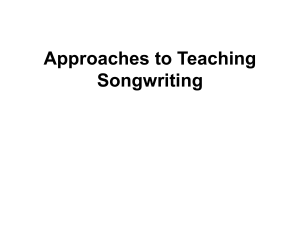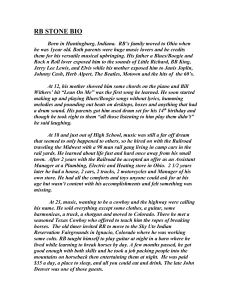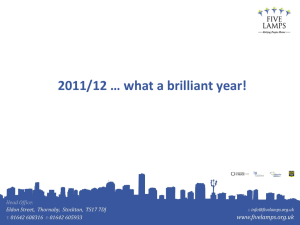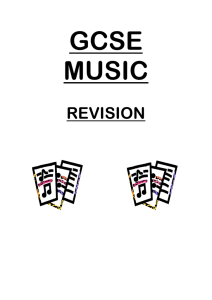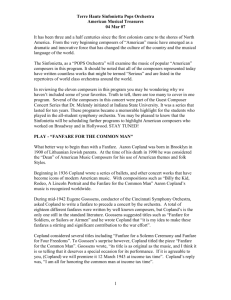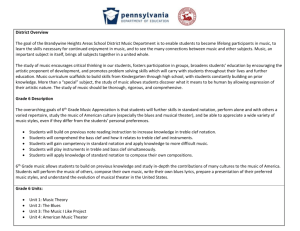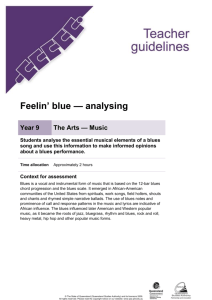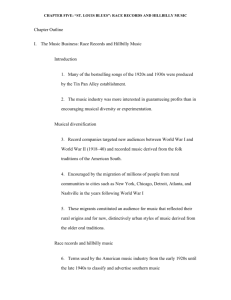Early American Music
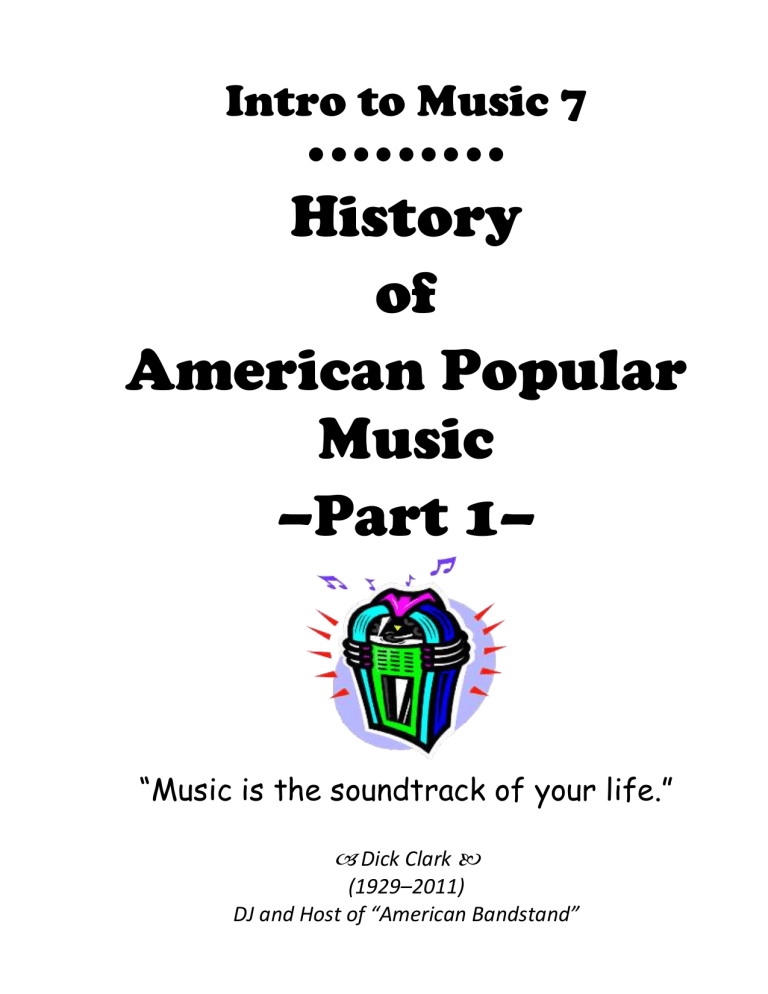
Intro to Music 7
•••••••••
History of
American Popular
Music
–Part 1–
“Music is the soundtrack of your life.”
Dick Clark
(1929–2011)
DJ and Host of “American Bandstand”
2
History of
American Popular
Music
•••••••••
Early American
Music to the
1950s
3
BEFORE POP MUSIC AS WE KNOW IT TODAY
A.
____ CLASSICAL _____________ Music—Popular music of its day, from Europe and other countries
1.
____ OPERA ____________—Musical play where everything is sung a.
______ ARIA _______—Song from opera that became popular
2.
____ ORCHESTRA ________—Large group of instruments with no singing
B.
Early American _______ FOLK MUSIC _______________________________
1.
_________ STEPHEN FOSTER __________________________________ (1826–1864) a.
From _____ LAWRENCEVILLE, PA (NEIGHBORHOOD OF PITTSBURGH) ___________________
1) ___ “OH, SUSANNA” _____________________________________________
2) ___ “CAMPTOWN RACES” ________________________________________
C.
_____ PATRIOTIC ___________________________ Music
1.
_____ JOHN PHILLIP SOUSA __________________________ (1854–1932) a.
Wrote music for ____ MARCHING BANDS ________________________________
1) Known as ___ “THE MARCH KING” ____________________________________ b.
____ ”STARS AND STRIPES FOREVER” ______________________
2.
_____ GEORGE M. COHAN _________________________________________(1878–1942) a.
Wrote and performed in _____ STAGE MUSICALS ________________________________ b.
____ “YANKEE DOODLE DANDY” ______________________ c.
____ “OVER THERE” ______—popular during _______ WORLD WAR I __________
D.
_____ AMERICAN MUSICAL THEATER _____
1.
History goes back to _____ OPERA _____
2.
_____ VAUDEVILLE _____—Traveling comic variety shows in the early 1900s
3.
Stage musicals and _________ MUSICAL FILMS _________ were popular in the 1920s and 1930s. a.
The ____ GREAT DEPRESSION _______________ caused them to be less popular.
4.
The Golden Age of American musical theater (40s to 60s) began with ___ OKLAHOMA!
_______
4
E.
_____ JAZZ _________________
1.
______ RAGTIME ___________ a.
Popular ___ JAZZ PIANO __________ music b.
Used a lot of ____ SYNCOPATION ____________
1) Very _____ RHYTHMIC ________ music not common to classical music c.
__________ ”THE ENTERTAINER”—SCOTT JOPLIN ______________________
2.
______ SWING ___________—also known as _____ “BIG BAND” __________ music a.
Most popular from ______ 1920s THROUGH 1940s ______________ b.
Size ranged between ________ 15 AND 30 ____________ members c.
Music that was mostly for _____ FUN AND DANCING ____________ d.
During WWII it helped to take people’s minds off of the _________ WAR ___________ and the __________ BAD ECONOMY _______________ e.
______ “IN THE MOOD”—GLENN MILLER ORCHESTRA ______________________________ f.
______ “SING, SING, SING”—BENNY GOODMAN ORCHESTRA _________________________
1) Known as __________ “THE KING OF SWING” ___________________________________
2) The first to have both ______ BLACKS _____ and ______ WHITES ______ in his orchestra g.
______ BOOGIE WOOGIE BUGLE BOY—ANDREW SISTERS ___________________________
3.
_____ CROONING ______________ a.
Coroners began adding _________ PERSONAL STYLE ______________ into their singing b.
___ ”PENNIES FROM HEAVEN”—BING CROSBY _____________________________________ c.
___ ”I’LL NEVER SMILE AGAIN”—FRANK SINATRA ___________________________________ d.
___ ”MONA LISA”—NAT KING COLE ______________________________________________
5
4.
_____ BLUES _____________________ a.
Originated from ________ SLAVE __________________________ music
1) They brought their ________ AFRICAN CULTURE _______________ with them
2) Came from the _______ MISERY _______ of their hard lives b.
________ ”STORMY BLUES”—BILLIE HOLIDAY __________________________ c.
________ ”BASIN STREET BLUES”—LOUIS ARMSTRONG __________________ d.
________ ”I’M YOUR HOOCHIE COOCHIE MAN’”—MUDDY WATERS _________________
5.
_____ GOSPEL __________________ a.
Religious or ______ SACRED _________ music that originated from slave music b.
Also known as ______ SPIRITUALS ___________________ c.
____ ”SWING LOW, SWEET CHARIOT” ____________________________________________
6.
______ RHYTHM & BLUES (R&B) ____________________________________________________ a.
Combination of _____ BLUES __________ and __________ GOSPEL ___________ styles b.
_______ ”MAMA, HE TREATS YOUR DAUGHTER MEAN”—RUTH BROWN _________________ c.
_______ ”CALDONIA”—LOUIS JORDAN ____________________________________________ d.
_______ ”BO DIDDLEY”—BO DIDDLEY _____________________________________________ e.
_______ ”AIN’T THAT A SHAME”—FATS DOMINO ___________________________________
F.
_____ COUNTRY _________________
1.
Originated in the ______ RURAL SOUTHEAST ________________
2.
Known as: a.
____ HILLBILLY _________, ____ MOUNTAIN ___________, and ____ BLUEGRASS __________
3.
Primary instruments: a.
_____ FIDDLE _______ b.
_____ BANJO _______ c.
_____ GUITAR _______
6
4.
Songs were simple and usually about: a.
_____ RURAL LIFE _______ b.
_____ RELIGION _______ c.
_____ SIMPLE, EVERYDAY TOPICS _______
5.
Most early country musicians were _____ COMMON LABORERS _______with other jobs and performed on the side a.
_____ FARMERS _______ b.
_____ RAILROAD WORKERS _______ c.
_____ MILL WORKERS _______ d.
_____ COAL MINERS _______
6.
Early _______ RADIO ________ helped hillbilly music to become popular a.
_____ ”BARN DANCE” _______ broadcasts were variety shows with a “family gathering” feel
1) Eventually led to the ____ GRAND OLE OPRY _______________________________ b.
Radio stations in other cities helped to spread this music north:
1) ________ NASHVILLE _____________
2) _______ CINCINNATI _____________
3) ________ CHICAGO ______________
7.
Examples: a.
_____ ”WAITING FOR A TRAIN”—LITTLE JIMMIE RODGERS _______(1930s) b.
_____ ”BACK IN THE SADDLE AGAIN”—GENE AUTRY _______(1940s)
1) From Texas and started the “cowboy” image by the way he ________ DRESSED ________ c.
______ ”I’M SO LONESOME I COULD CRY”—HANK WILLIAMS _____(1940s) d.
______ ”DON’T TAKE YOUR GUNS TO TOWN”—JOHNNY CASH ______(1950s)
7
MUSIC PRODUCTION, SALES, AND TECHNOLOGY
A.
Music Production and Sales Developments
1.
______ TIN PAN ALLEY ____________—Area in New York City where many music publishing companies and songwriters were located a.
Sold ___ SHEET MUSIC ___________________—printed music to be played on the piano b.
Hired ___________ SONGWRITERS _____________ to produce music to sell and
__________ SONG PLUGGERS ___________ to demonstrate songs to promote sales c.
______ PERFORMERS _______ came to find new music for their acts
2.
_______ BILLBOARD __________—Weekly international magazine devoted to the music industry a.
Tracks the most popular _____ SONGS AND ALBUMS ______ in various categories:
1) ______ HOT 100 ____________________—Top 100 songs
2) ______ BILLBOARD 200 ______________—Top 200 albums
3) ______ INDVIDUAL CHARTS _____________—Rock, Country, Dance, Jazz, Classical,
Christian, Latin, Pop, Electronic, R&B, Rap, Comedy, etc. a) http://www.thefullwiki.org/Billboard_charts b.
________ RANKING ____________ on the charts is based on:
1) ______ MUSIC SALES—CDs, DOWNLOADS, STREAMING ____________________
2) ______ RADIO AIRPLAY ______________________________________________
B.
Recording Devices
1.
______ PHONOGRAPH ____________—First device for recording and replaying sound a.
Invented by ___ THOMAS EDISON _______________________________ in 1877 b.
Recorded onto ____ CYLINDERS __________ that could be played only once
2.
______ GRAMOPHONE ____________ a.
Invented by ___________ EMILE BERLINER ______________ in 1887 b.
Recorded onto flat discs or ______ RECORDS _________ that could be played multiple times
8
C.
Music Broadcasting
1.
_____ CRYSTAL SET _______________—Earliest radio receiver a.
Used ______ HEADPHONES ______________ because of its weak sound
2.
_________ TUBE SET ______________—Replaced crystal set a.
Had _____ SPEAKERS ___________ to project sound b.
____ FAMILIES ___________ sat around it to listen to _______ RADIO SHOWS ______
1) Predecessor to the ____ TELEVISION __________
3.
_____ KDKA _______________—First commercial radio station, created in 1920
4.
_____ MTV __________—First TV station devoted to music, primarily videos
D.
Music Recording and Playback
1.
_______ JUKEBOX ______________________________ a.
Became very popular during _________ WORLD WAR II ______________________________
1) Allowed people to enjoy music ____ WITHOUT THE LIVE BAND _____________________
2.
_____ RECORDS ____________________ a.
___ RPM—REVOLUTIONS PER MINUTE ______________________________________
1) ______ 78 RPM __________________________ a) First records that played __________ ONLY ON ONE SIDE __________________
2) ______ 33⅓ RPM ___________________ a) Larger 12-inch disc with ____ MULTIPLE SONGS ______________ on each side b) Referred to as ____ “LP”—LONG-PLAYING ___________
3) _____ 45 RPM ___________________________ a) Referred to as a __________ “SINGLE” ___________ with one song on each side
3.
_____ 8-TRACK TAPES ___________________—Most popular in the 1970s
4.
_____ CASSETTE TAPES __________________—Most popular in the late 1970s and 1980s
5.
_____ COMPACT DISCS (CDs) _____________—Became popular in the 1990s
9
E.
Music Awards
1.
__________ GRAMMY AWARDS ________________ a.
Established in 1959 by _____ NATIONAL ACADEMY OF RECORDING ARTS AND SCIENCES ____ b.
Given for _______ OUTSTANDING ACHIEVEMENT _____ in the music industry c.
Named for and fashioned after the _____ GRAMOPHONE ______
2.
Other awards include: a.
____ MTV MUSIC VIDEO AWARDS ____ b.
____ AMERICAN MUSIC AWARDS ____ c.
____ COUNTRY MUSIC AWARDS ______ d.
____ ACADEMY AWARDS _____—Best original song for a film
10
